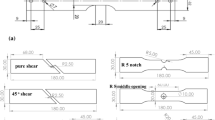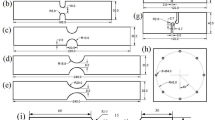Abstract
It is of vital importance to improve the lightweight and crash safety of automobiles to accurately characterize the fracture features of automotive aluminum alloys under complex working conditions. This study starts with mechanical tests of 6061-T5 aluminum alloy under different stress states and strain rates, the results of which show obvious strain rate sensitivity in such a material. Then, the parameters of the Gurson–Tvergaard–Needleman_Johnson–Cook (GTN_JC) damage model are calibrated based on the test data under different stress states. In view of the fact that the GTN model cannot reflect the strain rate effect, the yield stress is introduced into the strain rate term to modify its hardening stage; in addition, the relationships among \({f}_{c}\),\({f}_{F}\) and the strain rate are established to modify its fracture stage. The modified GTN model can accurately predict the plastic and fracture features of 6061-T5 aluminum alloy at different strain rates. Finally, the modified GTN damage model is programmed as a UMAT in LS-DYNA for simulation analysis. The results of the simulation and the test agree with each other very well, proving the superior reliability of the UMAT.












Similar content being viewed by others
References
H.Z. Lu, M.T. Ma, J.H. You and Z.G. Li, Application of Aluminum Alloy in Auto Panel and Research Development of Related Technology[J], World Nonferrous Metals, 2008, 5, p 66–70. (in Chinese)
S. Simunovic, P. Nukala, J. Fekete, D. Meuleman and M. Milititsky, Modeling of Strain Rate Effects in Automotive Impact[J], SAE Trans., 2003, 112, p 733–743.
Y.X. Yan, Q. Sun, J.J. Chen and H.L. Pan, The Initiation and Propagation of Edge Cracks of Silicon Steel During Tandem Cold Rolling Process Based on the Gurson-Tvergaard-Needleman Damage Model[J], J. Mater. Process. Technol., 2013, 213(4), p 598–605.
B.G. Teng, W.N. Wang, Y.Q. Liu and S.J. Yuan, Bursting Prediction of Hydroforming Aluminum Alloy Tube Based on Gurson-Tvergaard-Needleman Damage Model[J], Procedia Eng., 2014, 81, p 2211–2216.
Q. Guo, F.G. Lu, H.C. Cui, R.J. Yang, X. Liu and X.H. Tang, Modelling the Crack Propagation Behavior in 9Cr/Cr Mo V Welds[J], J. Mater. Process. Technol., 2015, 226, p 125–133.
A.L. Gurson, Continuum Theory of Ductile Rupture by Void Nucleation and Growth: Part I—Yield Criteria and Flow Rules for Porous Ductile Media[J], J. Eng. Mater. Technol., 1977, 99(1), p 2–15.
V. Tvergaard and A. Needleman, Analysis of the Cup-Cone Fracture in a Round Tensile Bar[J], Acta metallurgic, 1984, 32(1), p 157–169.
H. Zhu, L. Zhu and J.H. Chen, Damage and Fracture Mechanism of 6063 Aluminum Alloy Under Three Kinds of Stress States[J], Rare Met., 2008, 01, p 64–69.
T. Petit, J. Besson, C. Ritter, K. Colas, L. Helfen and T.F. Morgeneyer, Effect of Hardening on Toughness Captured by Stress-Based Damage Nucleation in 6061 Aluminum Alloy[J], Acta Mater., 2019, 180, p 349–365.
H. Wu, W.C. Xu, D.B. Shan and B.C. **, Mechanism of Increasing Spinnability by Multi-Pass Spinning Forming–Analysis of Damage Evolution Using a Modified GTN Model[J], Int. J. Mech. Sci., 2019, 159, p 1–19.
Y.B. Chen, C.Y. Zhang and C. Vare, An Extended GTN Model for Indentation-Induced Damage[J], Comput. Mater. Sci., 2017, 128, p 229–235.
M. Feucht, D.Z. Sun, T. Erhart, T. Frank. Recent Development and Applications of the Gurson Model[C]. 5. LS-DYNA Anwenderforum, Ulm, 2006
M. Roth, S. Kolling. Crash and Vibration Analysis of Rotors in a Roots Vacuum Booster[C]// 7th European LS-DYNA Conference, 2009
S.B. Lu, L.Y. Zhou and S. Guo, Characterization of Mechanical Properties of Aluminium Alloy 6061–T6 and Low Carbon Steel Q235 Based on Gurson-JC Model[J], J. Hefei Univ. Technol. (Nat. Sci.), 2014, 37(6), p 641–644. ((in Chinese))
L. Ying, T.H. Gao, H. Rong, X. Han, P. Hu and W.B. Hou, On the Thermal Forming Limit Diagram (TFLD) with GTN Mesoscopic Damage Model for AA7075 Aluminum Alloy: Numerical and Experimental Investigation[J], J. Alloys Compd., 2019, 802, p 675–693.
P. Verleysen and J. Peirs, Quasi-Static and High Strain Rate Fracture Behaviour of Ti6Al4V[J], Int. J. Impact Eng., 2017, 108, p 370–388.
G. Li and S.S. Cui, Meso-Mechanics and Damage Evolution of AA5182-O Aluminum Alloy Sheet Based on the GTN Model[J], Eng. Fract. Mech., 2020, 235, p 107162.
S. Hao and W. Brocks, The Gurson-Tvergaard-Needleman-Model for Rate and Temperature-Dependent Materials with Isotropic and Kinematic Hardening[J], Comput. Mech., 1997, 20(1–2), p 34–40.
C. Ji, Z.G. Li and J.G. Liu, Development of an Improved MMC-based Fracture Criterion Characterizing the Anisotropic and Strain Rate-Dependent Behavior of 6061–T5 Aluminum Alloy[J], Mech. Mater., 2020, 150, p 103598.
B.G. Teng, W.N. Wang and Y.C. Xu, Ductile Fracture Prediction in Aluminium Alloy 5A06 Sheet Forming Based on GTN Damage Model[J], Eng. Fract. Mech., 2017, 186, p 242–254.
G.R. Johnson and W.H. Cook, Fracture Characteristics of Three Metals Subjected to Various Strains, Strain Rates, Temperatures and Pressures[J], Eng. Fract. Mech., 1985, 21(1), p 31–48.
Z.G. Li, J.J. Wang, H.F. Yang, J.G. Liu and C. Ji, A Modified Johnson-Cook Constitutive Model for Characterizing the Hardening Behavior of Typical Magnesium Alloys Under Tension at Different Strain Rates: Experiment and Simulation[J], J. Mater. Eng. Perform., 2020, 29(12), p 8319–8330.
R. Safdarian, Forming Limit Diagram Prediction of 6061 Aluminum by GTN Damage Model[J], Mech. Ind., 2018, 19(2), p 202–213.
B.V. Farahan, R. Amaral, J. Belinha, P.J. Tavares and P. Moreira, A GTN Failure Analysis of an AA6061-T6 Bi-failure Specimen[J], Procedia Struct. Integr., 2017, 5, p 981–988.
W.N. Wang. Fracture prediction of 5A06 aluminum alloy sheet in different stress states[D]. Harbin Institute of Technology, 2015. (in Chinese)
I.S. Boldyrev, I.A. Shchurov and A.V. Nikonov, Numerical Simulation of the Aluminum 6061–T6 Cutting and the Effect of the Constitutive Material Model and Failure Criteria on Cutting Forces’ Prediction[J], Procedia Eng., 2016, 150, p 866–870.
W. Volk. New experiment and numerical approach in the evaluation of the FLD with the FE-method[C]// In Proceedings of the FLC-Zurich 06, Zurich, Switzerland, 2006.
Z.Y. Chen and X.H. Dong, The GTN Damage Model Based on Hill’48 Anisotropic Yield Criterion and its Application in Sheet Metal Forming[J], Comput. Mater. Sci., 2009, 44(3), p 1013–1021.
Acknowledgments
The authors acknowledge, with thanks, the financial support from the Bei**g Natural Science Foundation (No. L201010 and No. L212024) and the National Natural Science Foundation of China (Grant No. 51975041).
Author information
Authors and Affiliations
Corresponding author
Additional information
Publisher's Note
Springer Nature remains neutral with regard to jurisdictional claims in published maps and institutional affiliations.
Rights and permissions
About this article
Cite this article
Li, Z., Li, R., Ji, C. et al. Development of a Modified Gurson–Tvergaard–Needleman Damage Model Characterizing the Strain-Rate-Dependent Behavior of 6061-T5 Aluminum Alloy. J. of Materi Eng and Perform 31, 7662–7672 (2022). https://doi.org/10.1007/s11665-022-06789-2
Received:
Revised:
Accepted:
Published:
Issue Date:
DOI: https://doi.org/10.1007/s11665-022-06789-2




